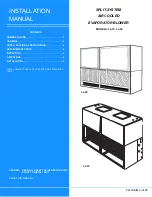
Quick Start Guide Guía de inicio rápido Guide de démarrage rapide
2
X7151190000
© 09/2019 ECHO Incorporated
MANUAL SAFETY SYMBOLS AND IMPORTANT INFORMATION
Throughout this manual and on the product itself, you will find safety alerts
and helpful, informational messages preceded by symbols or key words. The
following is an explanation of those symbols and key words and what they
mean to you.
The safety alert symbol accompanied by the word “DANGER” calls
attention to an act or condition which WILL lead to serious personal
injury or death if not avoided.
The safety alert symbol accompanied by the word “WARNING” calls
attention to an act or condition which CAN lead to serious personal injury
or death if not avoided.
The enclosed message provides information necessary for the protec-
tion of the unit.
Note
: This enclosed message provides tips for use, care and maintenance
of the unit.
GENERAL SAFETY REQUIRMENTS
Read and understand all provided literature before use. Failure to do so could
result in serious injury. Additional operating instructions are available from
your Authorized ECHO Dealer.
•
Operating a poorly maintained unit can result in serious injuries to
operator or bystanders. Always follow all maintenance instructions
as written, otherwise serious personal injury can result.
•
Use only approved attachments. Serious injury can result from the
use of a non-approved attachment combination. Do not attempt to
modify this product. Serious injury can result from the use of any
modified product.
•
Do not operate this unit when tired, ill, or under the influence of
alcohol, drugs, or medication. Serious injury can result from the
use of this product in an impaired state.
•
Moving parts can amputate fingers or cause severe injuries. Keep
hands, clothing and loose objects away from all openings. Always
stop engine, disconnect spark plug, and make sure all moving parts
have come to a complete stop before removing obstructions, clear-
ing debris, or servicing unit.
•
Eye protection that meets ANSI Z87.1 or CE requirements must be
worn whenever you operate the unit.
•
Operators who are sensitive to dust or other common airborne
allergens may need to wear a dust mask to prevent inhaling these
materials while operating unit. Dust masks can provide protection
against dust, plant debris, and other plant matter such as pollen.
Make sure the mask does not impair your vision, and replace the
mask as needed to prevent air restrictions.
•
This blower should be used for clearing leaves, grass, and dust in
yards, gardens, driveways, and parking lots only.
Use The Correct Personal Protection
Before Each Use Inspect:
•
For damaged parts.
•
Loose or missing fasteners.
•
For fuel leaks from any point of the fuel system (tank to carburetor).
Operating Reccomendations
•
Keep a firm grip on all handles.
•
Keep firm footing and balance.
•
Do not over-reach.
•
Keep all body parts away from hot surfaces.
•
Do not operate from ladders, maintaining balance will be difficult
and could result in serious injury.
•
Read and understand all provided literature before use. Failure to
do so could result in serious injury.
•
Operate power equipment only at reasonable hours, not early in the
morning or late at night when people might be disturbed. Comply
with times listed in local ordinances.
•
To reduce sound levels, limit the number of pieces of equipment
used at any one time.
•
Operate blowers at the lowest possible engine speed to do the job.
•
Use rakes and brooms to loosen debris before blowing.
•
In dusty conditions, slightly dampen surfaces when water is avail-
able.
•
Conserve water by using blowers instead of hoses for many lawn
and garden applications, including areas such as gutters, screens,
patios, grills, porches, and gardens.
•
Avoid blowing debris towards people, pets, open windows, or cars
when using unit.
•
Use the full blower nozzle extension when blowing.
•
After using blowers and other equipment, CLEAN UP! Dispose of
debris in trash receptacles.
Exhaust Gases
Do not operate this product indoors or in inadequately ventilated areas.
Engine exhaust contains poisonous emissions and can cause serious
injury or death.
Fuel Handling
•
Fuel is VERY flammable. Use extreme care when mixing, storing or
handling, or serious personal injury can result.
•
Mix and pour fuel outdoors where there are no sparks and flames.
•
Slowly remove the fuel cap only after stopping the engine.
•
Do not smoke while fueling or mixing fuel.
•
Wipe spilled fuel from the unit.
•
Move at least 3 m (10 ft) away from the fueling source and site
before starting engine.
Work Area
•
Review the area to be cleared. Remove potential hazzards such as
rocks, broken glass, nails, wire, or metal objects, which can be thrown.
•
Clear the area of children, bystanders and pets.
•
At a minimum, keep all children, bystanders and pets outside a 15m (50
ft) radius.
•
Outside the 15 m (50 ft) zone, there is still a risk of injury from thrown
objects.
•
Bystanders should be encouraged to wear eye protection.
•
Avoid blowing debris towards people, pets, open windows, or vehicles
when using unit. If you are approached, stop the engine.
ALWAYS WEAR
NEVER WEAR
Hearing Protection
Loose Clothing
Eye Protection
Jewelry
Heavy, Long Pants
Short Pants, Short Sleeve Shirt
Boots
Sandals
Gloves
Barefoot
Long-Sleeve Shirt
Long Hair Below Shoulders










































